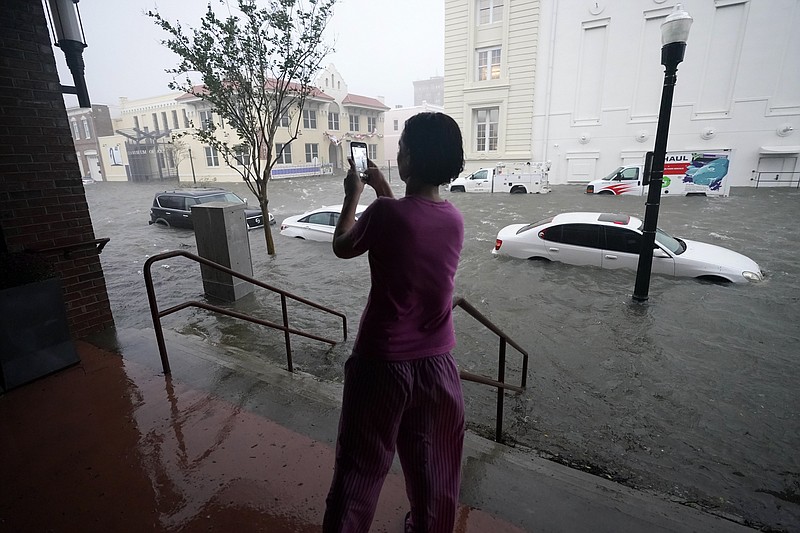PENSACOLA, Fla. (AP) - Hurricane Sally lumbered ashore near the Florida-Alabama line Wednesday with 105 mph winds and rain measured in feet, not inches, swamping homes and trapping people in high water as it pushed inland for what could be a slow and disastrous drenching across the Deep South.
Moving at 3 mph, or about as fast as a person can walk, the storm made landfall at 4:45 a.m. close to Gulf Shores, Alabama, about 30 miles from Pensacola. It accelerated to a light jog as it battered the Pensacola and Mobile, Alabama, metropolitan areas encompassing nearly 1 million people.
It cast boats onto land or sank them at the dock, flattened palm trees, peeled away roofs, blew down signs and knocked out power to more than a half-million homes and businesses. A replica of Christopher Columbus' ship the Nina was missing from the Pensacola waterfront, police said.
Sally tore loose a barge-mounted construction crane, when then smashed into the new Three Mile Bridge over Pensacola Bay, causing a section of the year-old span to collapse, authorities said. The storm also ripped away a large section of a newly renovated fishing pier at Alabama's Gulf State Park.
Emergency crews plucked people from numerous flooded homes. In Escambia County, which includes Pensacola, more than 40 were rescued within a single hour, including a family of four found in a tree, Sheriff David Morgan said.
By early afternoon, Sally had weakened into a tropical storm, with winds down to 70 mph, but the worst may be yet to come, with heavy rain expected into Thursday as the storm pushes inland over Alabama and into Georgia. For much of the day, it was moving at just 5 mph, concentrating the amount of rain dropped on any one place.
Morgan estimated thousands more will need to flee rising waters in the coming days. County officials urged residents to rely on text messages for contacting family and friends to keep cellphone service open for 911 calls.
"There are entire communities that we're going to have to evacuate," the sheriff said. "It's going to be a tremendous operation over the next several days."
West of Pensacola, power poles leaned halfway over in Perdido Key, Florida, as Joe Mirable arrived at his real estate business to find the two-story building shattered, its contents scatted on the ground. Digging through the ruins, Mirable pointed out a binder labeled "Hurricane Action Plan."
"I think the professionals got this one wrong," he said before the wind blew away his hat.
More than 2 feet of rain was recorded near Naval Air Station Pensacola, and nearly 3 feet of water covered streets in downtown Pensacola, the National Weather Service reported.
"It's not common that you start measuring rainfall in feet," forecaster David Eversole said. "Sally's moving so slowly, so it just keeps pounding and pounding and pounding the area with tropical rain and just powerful winds. It's just a nightmare."
It was the second hurricane to hit the Gulf Coast in less than three weeks and the latest blow in one of the busiest hurricane seasons ever recorded, so frenetic that forecasters have nearly run through the alphabet of storm names with 2 months still to go. At the start of the week, Sally was one of a record-tying five storms churning simultaneously in the Atlantic, strung out like charms on a bracelet.
Like the wildfires raging on the West Coast, the onslaught of hurricanes has focused attention on climate change, which scientists said is causing slower, rainier, more powerful and more destructive storms.
An emergency crew rescued two people on Dauphin Island, Alabama, after the hurricane ripped the roof off their home and the rest of the house began to crumble.
"As things started to peel off and fall apart, they got scared and called for assistance," Mayor Jeff Collier said. He said no one was injured.
In Orange Beach, Alabama, the wind blew out the walls in one corner of a condominium building, exposing the interiors of condos on at least five floors, video posted online showed. At least 50 people were rescued from flooded homes and taken to shelters, Mayor Tony Kennon said.
"We got a few people that we just haven't been able to get to because the water is so high," Kennon said. "But they are safe in their homes. As soon as the water recedes, we will rescue them."
In downtown Pensacola, water rushed down some streets like river rapids, forming whitecaps as it slapped against buildings and rose above the tires on cars.
Before sunrise, water was up to the doors of Jordan Muse's car outside the Pensacola hotel where her family took shelter after fleeing their mobile home. The power failed early in the morning, making it too stuffy to sleep. Her 8-year-old son played with toys underneath the hotel room desk as Muse peered out the window, watching rain fly by in sheets.
"The power trucks are the only ones above water, and they're the biggest," Muse said. "I can't believe it got so bad."
National Hurricane Center forecaster Stacy Stewart said the rain will be "catastrophic and life-threatening" over portions of the Gulf Coast. Forecasters predicted 10-20 inches of rain, with up to 35 inches in some spots.

